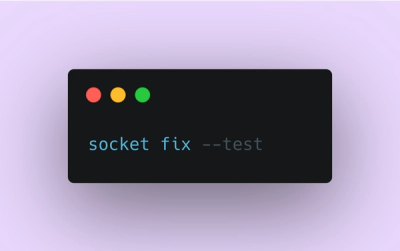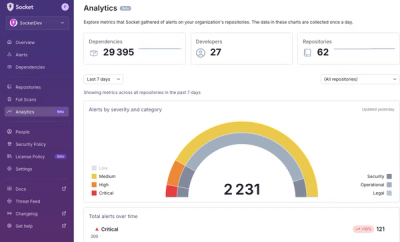
Product
Introducing Socket Fix for Safe, Automated Dependency Upgrades
Automatically fix and test dependency updates with socket fix—a new CLI tool that turns CVE alerts into safe, automated upgrades.
@stowklabs/react-geosuggest
Advanced tools
A React autosuggest for the Google Maps Places API. You can also define your own suggests as defaults. Works with Preact, too.
Live demo: ubilabs.github.io/react-geosuggest
As this component uses the Google Maps Places API to get suggests, you must include the Google Maps Places API in the <head> of your HTML:
<!DOCTYPE html>
<html>
<head>
…
<script src="https://maps.googleapis.com/maps/api/js?key=YOUR_API_KEY_HERE&libraries=places"></script>
</head>
<body>
…
</body>
</html>
Visit the Google Developer Console to generate your API key. The API's that you have to enable in your Google API Manager Dashboard are Google Maps Geocoding API, Google Places API Web Service and Google Maps Javascript API.
The easiest way to use geosuggest is to install it from NPM and include it in your own React build process (using Browserify, Webpack, etc).
You can also use the standalone build by including dist/react-geosuggest.js in your page. If you use this, make sure you have already included React, and it is available as a global variable.
npm install react-geosuggest --save
The Geosuggest works out of the box by just including it. However, you can customize the behaviour with the properties noted below.
import Geosuggest from 'react-geosuggest';
<Geosuggest />
var Geosuggest = require('react-geosuggest').default;
<Geosuggest />
Type: String
Default: Search places
The input field will get this placeholder text.
Type: String
Default: ''
An initial value for the input, when you want to prefill the suggest.
Type: String
Default: ''
Add an additional class to the geosuggest container.
Type: Object
Default: { 'input': {}, 'suggests': {}, 'suggestItem': {} }
Add an additional style to Geosuggest.
This would support overriding/adding styles to the input suggestList and suggestItem.
Type: String
Default: ''
Add an additional class to the input.
Type: Boolean
Default: false
Defines whether the input is disabled.
Type: google.maps.LatLng
Default: null
To get localized suggestions, define a location to bias the suggests.
Type: Number
Default: 0
The radius in meters defines the area around the location to use for biasing the suggests. It must be accompanied by a location parameter.
Type: LatLngBounds
Default: null
The bounds to use for biasing the suggests. If this is set, location and radius are ignored.
Type: String or Array
Default: null
Restricts predictions to the specified country (ISO 3166-1 Alpha-2 country code, case insensitive). E.g., us, br, au. You can provide a single one, or an array of up to 5 country code strings.
Type: Array
Default: null
The types of predictions to be returned. Four types are supported: establishment for businesses, geocode for addresses, (regions) for administrative regions and (cities) for localities. If nothing is specified, all types are returned. Consult the Google Docs for up to date types.
Type: Array
Default: []
An array with fixtures (defaults). Each fixture has to be an object with a label key in it. Optionally provide a location, but the Geosuggest will geocode the label if no location is provided.
You can also add a className key to a fixture. This class will be applied to the fixture item.
Type: Number
Default: 10
Maximum number of fixtures to render.
Type: Array
Default: null
By default Google returns all fields when getting place details which can impact billing. You can optionally pass an array of fields to include in place results to limit what is returned and potentially reduce billing impact. geometry will always be added as we depend on the location for the suggest selection.
Type: Object
Default: google.maps
In case you want to provide your own Google Maps object, pass it in as googleMaps. The default is the global google maps object.
Type: Boolean
Default: false
When the tab key is pressed, the onSelect handler is invoked. Set to true to not invoke onSelect on tab press.
Type: Boolean
Default: false
When the enter key is pressed, the onSelect handler is invoked. Set to true to not invoke onSelect on enter press.
Type: Number
Default: 250
Sets the delay in milliseconds after typing before a request will be sent to find suggestions.
Specify 0 if you wish to fetch suggestions after every keystroke.
Type: Number
Default: 1
Sets a minimum length of characters before a request will be sent to find suggestions.
Type: Boolean
Default: true
Highlights matched text.
Type: Function
Default: function() {}
Gets triggered when the input field receives focus.
Type: Function
Default: function(value) {}
Gets triggered when input field loses focus.
Type: Function
Default: function(value) {}
Gets triggered when input field changes the value.
Type: Function
Default: function(event) {}
Gets triggered when input field has a key pressed down. This event is triggered before onKeyPress.
Type: Function
Default: function(event) {}
Gets triggered when input field gets key press.
Type: Function
Default: function(suggest) {}
Gets triggered when a suggest got selected. Only parameter is an object with data of the selected suggest. This data is available:
label – Type String – The label nameplaceId – Type String – If it is a preset, equals the label. Else it is the Google Maps placeIDlocation – Type Object – The location containing lat and lnggmaps – Type Object – Optional! The complete response when there was a Google Maps geocode necessary (e.g. no location provided for presets). Check the Google Maps Reference for more information on it’s structure.Type: Function
Default: function(suggests, activeSuggest) {}
Gets triggered when the suggest list changes. Arguments include the suggest list and the current activeSuggest. Useful if you want to render the list of suggests outside of react-geosuggest.
Type: Function
Default: function(suggest) {}
Gets triggered when a suggest is activated in the list. Only parameter is an object with data of the selected suggest. This data is available:
label – Type String – The label nameplaceId – Type String – If it is a preset, equals the label. Else it is the Google Maps placeIDType: Function
Default: function(userInput) {}
Gets triggered when there are no suggest results found
Type: Function
Default: function(suggest) { return suggest.description; }
Used to generate a custom label for a suggest. Only parameter is a suggest (google.maps.places.AutocompletePrediction). Check the Google Maps Reference for more information on it’s structure.
Type: Function
Default: null
Used to customize the inner html of SuggestItem and allows for controlling what properties of the suggest object you want to render. Also a convenient way to add additional styling to different rendered elements within SuggestItem. The function is passed both the suggestion and the user input.
Type: Function
Default: function(suggest) {}
If the function returns true then the suggest will not be included in the displayed results. Only parameter is an object with data of the selected suggest. (See above)
Type: Boolean
Default: false
Automatically activate the first suggestion as you type. If false, the exact term(s) in the input will be used when searching and may return a result not in the list of suggestions.
Type: String
Default: null
If the label and a id prop (see "Others") were supplied, a <label> tag with the passed label text will be rendered. The <label> element's for attribute will correctly point to the id of the <input> element.
Type: String
Default: ''
Add an additional class to suggest list.
Type: String
Default: null
Additional className to toggle as the list of suggestions changes visibility.
Type: String
Default: ''
Add an additional class to suggest item.
Type: String,
Default: null
Additional className to add when a suggestion item is active.
Type: String,
Default: nope
Autocomplete input attribute.
All allowed attributes for input[type="text"]
All DOM clipboard events.
All DOM mouse events except for drag & drop.
These functions are accessible by setting "ref" on the component (see example below)
Call focus to focus on the element. The suggest list will be expanded with the current suggestions.
Call blur to blur (unfocus) the element. The suggest list will be closed.
It is possible to update the value of the input contained within the GeoSuggest component by calling the update function with a new desired value of the type String.
It is also possible to clear the value of the input contained within the GeoSuggest component by calling the clear function.
Same effect as hitting enter (will geocode the text inside of the input).
import React from 'react';
import ReactDOM from 'react-dom';
import Geosuggest from 'react-geosuggest';
class App extends React.Component {
/**
* Render the example app
*/
render() {
var fixtures = [
{label: 'Old Elbe Tunnel, Hamburg', location: {lat: 53.5459, lng: 9.966576}},
{label: 'Reeperbahn, Hamburg', location: {lat: 53.5495629, lng: 9.9625838}},
{label: 'Alster, Hamburg', location: {lat: 53.5610398, lng: 10.0259135}}
];
return (
<div>
<Geosuggest
ref={el=>this._geoSuggest=el}
placeholder="Start typing!"
initialValue="Hamburg"
fixtures={fixtures}
onSuggestSelect={this.onSuggestSelect}
location={new google.maps.LatLng(53.558572, 9.9278215)}
radius="20" />
{* Buttons to trigger exposed component functions *}
<button onClick={()=>this._geoSuggest.focus()}>Focus</button>
<button onClick={()=>this._geoSuggest.update('New Zealand')}>Update</button>
<button onClick={()=>this._geoSuggest.clear()}>Clear</button>
<button onClick={()=>this._geoSuggest.selectSuggest()}>Search</button>
</div>
)
}
/**
* When a suggest got selected
* @param {Object} suggest The suggest
*/
onSuggestSelect(suggest) {
console.log(suggest);
}
});
ReactDOM.render(<App />, document.getElementById('app'));
This component uses BEM for namespacing the CSS classes. So styling should be easy and without conflicts. See the geosuggest.css for an example styling.
The geosuggest__suggests--hidden class is added to hide the suggestion list. You should copy the style below into your CSS file.
.geosuggest__suggests--hidden {
max-height: 0;
overflow: hidden;
border-width: 0;
}
The above class is added whenever the suggestion list needs to be hidden. This occurs when the user selects an item from the list or when the user triggers the blur event on the input.
Similarly, you need to have the class geosuggest__item--active similar to this:
.geosuggest__item--active {
background: #267dc0;
color: #fff;
}
to see what item is selected, f.ex. when using the arrow keys to navigate the suggestion list.
Issues and pull requests are welcome!
Please read the guidelines in CONTRIBUTING.md before starting to work on a PR.
See LICENSE.md
FAQs
A React autosuggest for the Google Maps Places API.
The npm package @stowklabs/react-geosuggest receives a total of 3 weekly downloads. As such, @stowklabs/react-geosuggest popularity was classified as not popular.
We found that @stowklabs/react-geosuggest demonstrated a not healthy version release cadence and project activity because the last version was released a year ago. It has 1 open source maintainer collaborating on the project.
Did you know?

Socket for GitHub automatically highlights issues in each pull request and monitors the health of all your open source dependencies. Discover the contents of your packages and block harmful activity before you install or update your dependencies.

Product
Automatically fix and test dependency updates with socket fix—a new CLI tool that turns CVE alerts into safe, automated upgrades.

Security News
CISA denies CVE funding issues amid backlash over a new CVE foundation formed by board members, raising concerns about transparency and program governance.

Product
We’re excited to announce a powerful new capability in Socket: historical data and enhanced analytics.